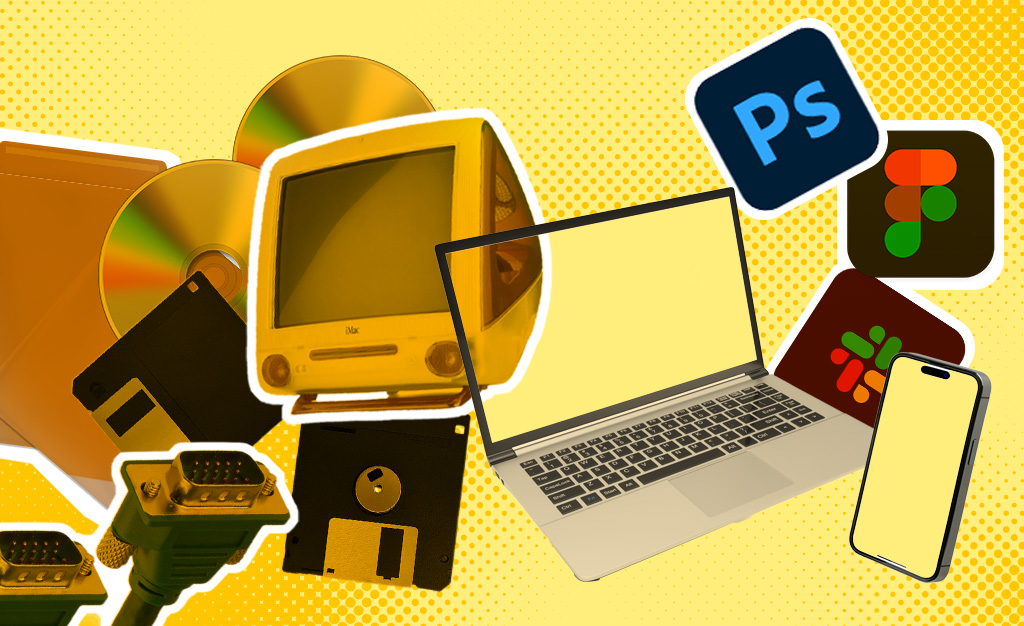Advances in technology, IT and design systems have had a huge impact on the productivity and performance of DesignStreet, and as an agency that has built its reputation on quality and agility, we have benefitted greatly from the explosion of innovative solutions available to us.
Going back 20 years or more, we were using the first Apple computers in the studio – the ones with purple-coloured domes at the back – while our Account Managers used the first white Apple laptops. They had limited computing power and had a cute white light that glowed on the power cord where it plugged into the laptop. We have kept one of each for when we showcase memorabilia one day – maybe when we turn 30!
Security of artwork files and client assets was as important then as it is today, and we had a process where we had automatic overnight backup to an offsite server at our IT specialist’s facility, so that if anything happened to our internal server, the most we stood to lose in the event of a failure was one day’s artwork.
We also periodically downloaded all the completed jobs from our server and backed them up on DVDs for safe off-site storage. I still have hundreds of these in my garage at home, in the event that we ever need to retrieve artwork from the early 2000’s, right up until we stopped using them in 2016, and moved to cloud storage. Before DVDs were CDs.
Back in the day, print formed a high percentage of our work, and we always had a big printer such as a Konica Minolta or a Xerox pumping out big A3 sheets of artwork for our designers and account managers to review.
These would get marked up and were folded and stored in brown paper “Job bags”, and we used to either scan the printouts or fax them to clients, who would make handwritten markups on the print outs and scan them back to us. Sometimes the change process was a little tricky, with requests that were sometimes challenging to follow.
We had a big cutting table for the preparation of knife lines and for cutting out proofs to send to clients. In comparison to today, everything was manual and time consuming.
Today we have a network of the latest Apple computers, all networked with cloud storage and fast uploads and downloads via our internal server and Dropbox system. We transfer large artwork files to clients and suppliers via a secure FTP link and huge files can be moved around with the minimum of fuss, and the maximum of security.
The bulk of artwork review is done via PDFs with clients making comments via sticky notes in a digital review process where paper print outs are unnecessary. Email is king, and the vast majority of work evolves from stage to stage via emailed drafts between ourselves and the clients.
Our biggest test came during the pandemic, starting in March 2020. From one day to the next we made the decision that we had to work from the safety of home. Everyone packed up their laptops or desktop computers and took them home. Macumen, our IT partners for the past 15 years, did an amazing job by hooking us all up remotely, all linked to our server, over the course of one day!
We tapped into smart tools like Zoom, Dropbox and Slack, and we worked seamlessly producing the same volume of output with ease. In hindsight, our streamlined structure that emphasises individual designer and account manager autonomy and quality control, saw us delivering a high volume of work, accurately, with fast turnaround times.
Without realising it we were catapulted into the gap as an agile, reliable “can do” partner and our business growth accelerated through COVID-19 lockdowns and has maintained an upward path ever since.
Over the past year we have added Figma into the programs that we use when it comes to our in-house design systems. We are still deeply engaged with the Adobe Creative Suite, pairing it with Figma to get the most professional outcome for our clients.
We have enjoyed a major improvement in the ability to create on-brand creative modules for clients, and roll out variations with speed, precision and quality.
AI is a new frontier that we are exploring, and we have found applications that help with the manipulation of images and content creation. So far this is just peripheral, however we are alert to the potential that AI offers in terms of working faster, smarter and better in the future.
Our work rhythm sees us working three days together in the studio, and two days remotely. The systems and processes that we developed during COVID-19 lockdowns mean that we can have the best of both worlds – working together and collaborating in the studio, and working more flexibly to meet individual staff members’ needs.
Looking back, it was really hard work back then! We have come a long way and can’t wait to see what the future holds in terms of new technology and frontiers that we can’t yet imagine. One thing is for sure – we’ll adapt to keep a competitive edge in this exciting and fast-paced industry where only the best will do! And where only the fastest and fittest will survive.


[…] Check out Graham’s previous blog about graphic design technology over 25 years at DesignStreet here. […]